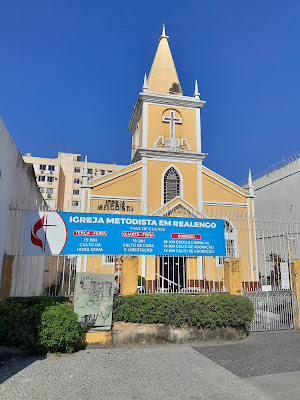Comprovadamente, denominadas Terras Realengas tem sua origem, segundo alguns historiadores, na carta régia de 27 de junho de 1814, através da qual Dom João, ainda príncipe, concedeu, em sesmaria ao senado da Câmara do Rio de Janeiro, os terrenos situados em Campo Grande chamados de realengos, porque advindos das conquistas territorial no começo do período colonial.
Igreja de Nossa Senhora da Conceição. (1908 - 116 anos)
Igreja Metodista de Realengo. (1913 - 111 anos)
A concessão das terras onde hoje é o bairro Realengo (para alguns era Real Engenho e juntou-se as duas palavras), central e periferia, foram destinadas apenas para servir de pastagem de gado bovino, fornecendo carne ao talhos (açougue) da cidade.
O bairro teve, como seus primeiros povoadores, escravos e imigrantes portugueses da Ilha dos Açores, por ordem do príncipe regente Dom João, futuro Dom João VI.
Estação de Trem de Realengo.
9a Brigada Militar Motorizada.
Imagens antigas de Realengo (de Internet)
Ao chegarem, se dedicaram à agricultura, levando produtos como açúcar, rapadura, álcool e cachaça pelo Porto de Guaratiba.
Fonte: www.wikipidia.org Realengo Rio de Janeiro














.jpeg)
.jpeg)
.jpeg)
.jpeg)
.jpeg)
.jpeg)
.jpeg)
.jpeg)
Fascinating historical insights on the Realengo neighborhood! The blend of historical events and architectural landmarks makes for an intriguing story.
ResponderExcluirI just posted a new blog post at www.melodyjacob.com, I invite you to read and let me know what you think about it. Thank you!
Lovely photos :-D
ResponderExcluirHello, Luiz! Thank you!
ResponderExcluirUn bonito lugar. Saludos
ResponderExcluirIt's fascinating to learn about the historical origins of Realengo and its development over time. The transformation from cattle pasture to a residential neighborhood with landmarks like the Church of Our Lady of Conception and the Methodist Church of Realengo reflects a rich and evolving history.
ResponderExcluirI just posted a new blog post at www.melodyjacob.com. I invite you to read it and let me know what you think about it. Thank you!
Oi Luiz,
ResponderExcluirAdorei conhecer a história dessas terras! E também gostei muito da street art! Uma boa tarde para você!
Alô, Alô, Realengo, aquele abraço! (disse Gil). O bairro merece ser conhecido e curtido!
ResponderExcluirAbração
Interesting information and very nice pictures.
ResponderExcluirMy good friend, I salute you!
The Church of Our Lady of Conception is very beautiful. The Methodist church is lovely as well. I like how they are both painted in bright yellow. For me, yellow is such a happy colour.
ResponderExcluirThis is a lovely place and it's interesting to read about its history. Many immigrants from Europe settled in Brasil over the years. Thank you for sharing.
Es un lindo lugar. Te mando un beso.
ResponderExcluirQuerido amigo, preciosas fotografías de un bello lugar. me encantó
ResponderExcluirAbrazos y besitos
Muita da emigração portuguesa saía, e ainda sai, das Ilhas (Açores e Madeira).
ResponderExcluirBfds
Prince Dom João granted the lands located in Campo Grande because they came from the territorial conquests early in the colonial period. Salute, Prince Dom João!
ResponderExcluirFotografie molto belle.Grazie
ResponderExcluirComparando las fotos antiguas con las tuyas saco la conclusión de ser una población moderna.
ResponderExcluirEl mural es precioso y mas viendo los detalles del mismo.
En el medievo español se denominaban localidades de realengo aquellas que dependían directamente del rey y al único que pagaban tributos ya que no dependían de un señor feudal.
Saludos.
Todo me gusta Luiz. Besos.
ResponderExcluir